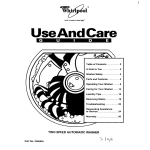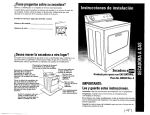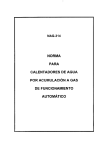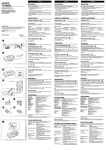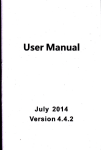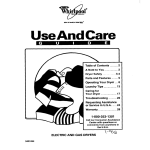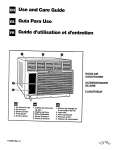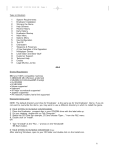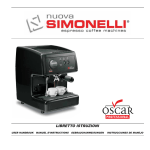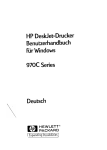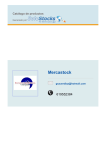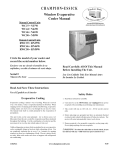Download Whirlpool 3397617 Clothes Dryer User Manual
Transcript
Before you start... Check location where dryer will be installed. Proper installation is your responsibility. The dryer must not be installed or stored in an area where it will be exposed to water and/or weather. Make sure you have everything necessary for correct installation. Grounded electrical supply See Electrical requirements, is required. Pages 3-4. Important: Observe all governing codes and ordinances. Open dryer and remove literature and parts packages. Support: Floor must be sturdy enough to support dryer weight of 175 pounds (79.4 kg) Level floor: 1-inch (2.5 cm) maximum slope under entire dryer. Electrical Shock Hazard It is the customer’s responsibility: To contact a qualified electrical installer. To assure that the electrical installation is adequate and in conformance with National Electrical Code, ANSVNFPA 70 latest edition*, and all local codes and ordinances. Failure to do so could result in death or serious injury. Four-inch metal exhaust duct is required. Check code requirements: Some codes limit or Do Not permit installation of clothes dryers in garages, closets, mobile homes, or sleeping quarters. Contact your local building inspector. Protection from the weather: Proper operation of dryer cycles requires temperatures above 45°F (7.2”C), or the dryer may not shut off when automatic cycles are used. Fire Hazard Do Not store gasoline, paint thinners, or other flammable materials near dryer. Fumes from such materials may result in fire or explosion. Never install dryer up against draperies or curtains or on carpet. Keep any and all items from falling or collecting behind the dryer. If you install the dryer in a garage, carport, or areas near vehicles where fumes from gasoline or other flammable materials may be present, the vapors may be heavier than air and remain near floor. Place dryer a minimum of 18 inches (45.7 cm) above floor. Check with your building inspector regarding requirements for this installation. Failure to follow these instructions could result in a fire or explosion. 42-318” (107.6 cm) Dryer door clearances Location must be large enough to fully open dryer door. See Page 10 for recessed and closet requirements. 15-318” (39.1 cm) (58.4 cm) + - r4 Copies of the standards be obtained from: *National Fire Protection Batterymarch Park Quincy, Massachusetts large sideswing door I Full-width hamper door Page 2 Extra-large hamper door (shown above) Mini-hamper door listed above Association 02269 may Tools and materials needed for installation: Electrical requirements It is the personal responsibility and obligation of the customer to contact a qualified electrician to assure that the electrical installation is adequate and is in conformance with the National Electrical Code, ANSVNFPA 70 - latest* and all local codes and ordinances. Copies of the standards be obtained from: *National Fire Protection Batterymarch Park Quincy, Massachusetts listed above may Association 02269 Important: Observe all governing codes and ordinances. l duct tape l/4” socket wrench or nut driver (shown) 1” socket wrench safety glasses Parts supplied for installation: Remove parts from packages. that all parts were included. 4 leveling legs literature Check package Electrical Shock Hazard Electrical ground is required on this appliance. Do Not modify the power supply cord plug. If it does not fit the outlet, have a proper outlet installed by a qualified electrician. Do Not have a fuse in the neutral or grounding circuit. A fuse in the neutral or grounding circuit could result in an electrical shock. Do Not use an extension cord with this appliance. Check with a qualified electrician to be sure this appliance is properly grounded. Do Not connect plug end of power supply cord into a live receptacle before connecting power supply cord to dryer terminal block. Do Not reuse old power supply cord. Failure to follow these instructions could result in death or serious injury. Power supply cord Use a new 30-amp power supply cord. Local codes may permit the use of a U.L.-listed, 120/240-volt minimum, 30-ampere, dryer power supply cord kit (pigtail). Power supply cord should be Type SRD or SRDT and be at least four feet (1.2 m) long. The wires that connect to the dryer must end with ring terminals or spade terminals with upturned ends. A 3/4”, U.L.-listed strain relief must be installed where the power supply cord connects to the dryer (see Figures 1 and 2). upturned rina terSinals to this conductor. If codes permit and a separate grounding wire is used, it is recommended that a qualified electrician determine that the grounding path is adequate. A three-wire or four-wire, single phase 120/240-volt, 60-Hz, AC-only, electrical supply (or three-wire or four-wire 120/208-volt if specified on serial/rating plate) is required on a separate 30-ampere circuit, fused on both sides of the line. A time-delay fuse or circuit breaker is recommended. w wirina 314” U.L.-listed / strain relief NEUTRAL (white or center) Three-wire power supply cord NEMA lo-30P Figure 1 314” U.L.-listed strain relief \ F NEUTRAL (white), NEUTRAL grounding A wiring diagram the console back panel dryer. ends or on of prong (green) ring \ terminals Four-wire power supply cord (Mobile home or other four-wire installations) NEMA 14-30P Figure 2 Page 3 For use where flexible power local codes permit supply cord. Electrical connection use of Ill @ @ i..: three-wire receptacle(lO-30R) Figure 3 four-wire receptacle(l4- 30R) Figure 4 The power supply cord must have three, No.-1 0 copper wires to match a three-wire receptacle of NEMA Type 1O-30R (see Figure 3). For mobile homes or other four-wire installations, the power supply cord must have four, No.-1 0 copper wires and match a four-wire receptacle of NEMA Type 14-30R (see Figure 4). The fourth wire (grounding conductor) must be identified with a green cover and the neutral conductor by a white cover. 3 . Attach 314” J.L.-listed strain relief (U.L. marking on strain ,elief) to the hole oelow terminal olock opening :see Figure 6). Tighten strain ,elief firmly to strAn relief cabinet so it is in (outside dryer) a horizontal oosition. Place Figure 6 3ower supply cord through strain relief. Where local codes permit connecting frame-grounding conductor to the neutral wire: This dryer is manufactured with the frame-grounding conductor connected to the NEUTRAL (center) the wiring harness at the terminal block. If local codes Do Not permit type of connection, use “Four-wire Connection” instructions. of this 4 . Loosen or remove terminal olock screws. Connect the neutral dire (white or center) of power ;upply cord under the center screw of the terminal block. Connect the other two wires to outer terminal block screws (see ‘igure 7). Tighten all terminal block screws ‘irmly. Center wire MUST be connected to zenter screw. Direct wire The dryer can be connected directly to fused disconnect or circuit breaker box with three-wire or four-wire flexible armored or non-metallic sheathed copper cable (with grounding wire). Do Not use two-wire with bare grounding wire. All current-carrying wires must be insulated, A conduit connector must be installed at junction box. USE ONLY lo-GAUGE SOLID COPPER WIRE, DO NOT USE ALUMINUM WIRE. Allow four feet of slack in the line so dryer can be moved if servicing is ever necessary. Electrical Shock Hazard Check that wiring you are using matches colors shown in illustrations and specified in instruction steps. If wiring does Not match, it is your responsibility to have a qualified electrician install the correct wiring. Failure to install the correct wiring could result in death or serious injury. strain relief screws Figure 7 1 . Turn power supply 2. Remove holddown ‘erminal block cover. Figure 5 Page 4 off. screw and 5'. Tighten 6 . Insert strain relief screws. tab of terminal block :over into slot of the dryer rear panel (see Figure 5). Secure cover with hold-down screw. 4 . Attach I n Turn power supply 3/4” U.L.rear listed strain relief (U.L. marking on strain relief) to the hole below terminal block rer opening (see figure 11). Tighten strain relief ’ P firmly to cabinet strain relief so it is in a horizontal position. (outs’de dVer) Place Power suPPlY 11 cable through strain relief. - ivI off. Figure Electrical Shock Hazard Do Not use two wire cable with a bare grounding wire. All currentcarrying wires must be insulated. Failure to install the correct wiring could result in death or serious injury. 2. Strip 3-l /2 inches (8.9 cm) of )uter covering from end of cable. If rsing three-wire cable with groundin vire, cut the bare wire even with )uter covering. Strip 1 inch (2.5 cm) )f insulation from the end of each Isulated wire (see Figure 8). Bare wire cut short. Wire is not used. Dryer is grounded through direc wire cable. ~~~~r~(i~ted \ 5 . Loosen or remove terminal block screws. Connect the neutral wire (white or center) of power supply cable under the center screw of the terminal block. Place the hook-shaped end of the wire over the terminal block screw with open side of the hook facing to the right. Squeeze hook end of wire together to form a loop. Connect the other two wires under the outer terminal block screws. Attach wires using the same method as the neutral wire (see Figure 12). Tighten all terminal block screws firmly. Center wire MUST be connected center screw. to external nter must (attache< at facton 1O-gauge, 3-wrre with grounding wire (Romex) Direct wire preparation Figure 8 u-shaped hook screws Shape the end of each wire into a ‘U” shaped hook (see Figure 9). 6 Figure 9 hold-down erminal block cover. screw and external grounding connector terminal block cover a 6 . Tighten 7 3 . Remove tab Figure 12 holddown screw Where local codes DO NOT permit connecting the frame-grounding conductor to the neutral (white) wire: 1 Q. Turn power supply off. &I. Complete Power supply cord Steps 2-3, Page 4 or Direct wire Steps 2-4, Page 5. Figure 13 3a. Remove the neutral grounding wire (green/yellow striped wire) from external grounding connector screw. Remove center terminal block screw and fasten neutral grounding wire to screw (see Figure 13). da. Complete Power supply cord Steps 4-6, Puge 4 or Direct wire Steps 5-7. Page 5. 5a. After reattaching the terminal block cover, connect separate copper grounding wire from external grounding connector to an adequate ground (see Figure 13a). If codes permit and a separate grounding wire is used, it i: recommended that a qualified electrician determine that the grounding path is adequate. strain relief screws. terminal block cover . Insert tab of terminal block cover into slot of the dryer rear panel (See Figure 10). Secure cove with hold-down screw. separate copper grounding wire connected and grounded to a grounded, metal, cold water pipe Figure 13a Figure 10 Page 5 a . Remove the center terminal )lock screw. Remove the neutral lreen with yellow stripe grounding vire from external grounding zonnector screw. Connect neutral Ireen with yellow stripe grounding vire and the neutral wire (white or :enter) of power supply cord under he center screw of terminal block. Connect the other two insulated vires under outer terminal block crews. Connect the green, grounding wire rom the power supply cord to the external grounding connector crew (see Figure 16). ‘ighten all terminal block screws irmly. Mobile home or other four-wire installations: 1 . Turn power supply off. 2 Strrp 5 inches (12.7 cm) n of outer covering from end of cable. Leave bare grounding wire at 5 inches (12.7 cm). Cut l-l /2” (3.8 cm) from 3 remaining insulated wires. Strip insulation back 1 inch (2.5 cm) (see Figure 17). 3-112” 3/4” U.L.- disconnect /+- / (e.9 cm),;;r (white stripped Electrical Shock Hazard Check that wiring you are using matches colors shown in illustrations and specified in instruction steps. If wiring does Not match, it is your responsibility to have a qualified electrician install the correct wiring. Failure to install the correct wiring could result in death or serious injury. external grounding :onnector \ ing minnlc err.... b$ % . y*;, green with yellow stripes (attached bt factory) II +,,enter fiLscrew I ( I grounding wire(Romex) Direct wire preparation Figure 17 Ireen vire ror- u-shaped hook black / strain relief Figure 18 1 . Turn power supply 2 . Remove terminal Figure 16 off. hold-down block cover. screw and 5 . Tighten 6 . Insert strain relief screws. 5” (12.7 cm) 7+ Shape the end of each wire into a ‘U” shaped hook (see Figure 18). The bare grounding wire must be 4-l /2” (11.4 cm) long after forming the hook. 3 . Remove hold-down terminal block cover, screw and external tab of terminal block :over into slot of the dryer rear lane1 (see Figure 14). Secure cover Nith hold-down screw. holddown screw Figure1 9 Figure 14 3 . Attach 3/4” U.1 listed strain relief (U.L. marking on strain relief) to the hole below I terminal block ” power opening (see roJgIY Figure 15). Tighten strain relief firmly to strain relief cabinet SO it iS in 0 (outside dryer) horizontal position. Figure 15 Place power supply cord through strain relief. Page 6 4 . Attach rear 3/4’ U.L.-listed strain relief (U.L. marking on strain relief) to the hole below terminal block openina (see Figure 2%). str&n relaf Tighten strain (outside dryer) relief firmly to Figure 20 cabinet so it is in a horizontal position. Place power supply cable through the strain relief. of 5 . Remove the center terminal Ilock screw. Remove the neutral lreen with yellow stripe grounding Yire from external grounding :onnector screw. Connect neutral Ireen with yellow stripe grounding Yire and the neutral wire (white or :enter) of power supply cable under the center screw of terminal Yock. Place the hook-shaped end )f the wire over the terminal block #crew with open side of the hook acing to the right. Squeeze hook 2nd of wire together to form a loop. Connect the other two insulated Mires under outer terminal block crews. Attach wires using the some nethod as the neutral wire. Connect the power supply cable Ibare) grounding wire to the external grounding connector crew (see Figure 21). ‘ighten all terminal block screws irmly. neutral green external StrazOCI(* \urki+t3 relief Figure 21 6 . Tighten 7 . Insert strain relief screws. tab of terminal block zover into slot of the dryer rear oanel (see Figure 19). Secure cover ,vith hold-down screw. Exhaust requirements Use duct tape to seal all joints. Do Not use screws to secure duct. Four-inch rigid metal pipe is preferred. Plan installation to use the fewest number of elbows and turns. exhaust air flow better Fire Hazard Do Not use non-metal, flexible duct. Do Not use metal duct smaller than four inches in diameter. Do Not use exhaust hoods with magnetic latches. Improper air supply for exhausting may result in a fire. Check that exhaust system is not longer than specified. Exhaust systems longer than specified will: - Accumulate lint. - Shorten the life of the dryer. - Reduce performance, resulting in longer drying times and increased energy usage. Failure to follow specifications may result in a fire. Do Not exhaust dryer into a chimney, furnace cold air duct, attic or crawl space, or any other duct used for venting. Clean the exhaust system every year. Do Not install flexible duct in enclosed walls, ceilings or floors. Accumulated lint could be fuel for a fire or cause moisture damage. Exhausting your dryer indoors is Not recommended. The moisture and lint indoors may cause: - Lint to gather inside and around the dryer and be a fuel for fire. - Moisture damage to woodwork, furniture, paint, wallpaper, carpet, etc. - Housecleaning problems and possible health problems. Failure to follow these instructions could result in a fire or serious injury or health problems. 1 good n Metal flexible duct must be fully extended and supported when the dryer is in its final position. DO NOT KINK OR CRUSH THE DUCT. The metal flexible duct must be completely open to allow adequate exhaust air to flow. Allow as much room as possible when using elbows or making turns. Bend duct gradually to ovoid kinking. Remove excess flexible duct to ovoid sagging and kinking that may result in reduced air flow. Exhaust outlet is located at the center of the bottom dryer back. The exhaust duct con be routed up, down, left, right or straight out the bock of the dryer. General space requirements ore provided on Page 10. Use the straightest path you con, where possible, to ovoid 90” turns, If using an existing exhaust system, clean lint from entire length of exhaust system. Make sure exhaust hood is not plugged with lint. The exhaust system should be inspected end cleaned yearly. Replace plastic exhaust duct with rigid metal or flexible metal duct. Page 7 Now start... With dryer in laundry NUMBEF OF 90” TURNS 4" (10.2 cm) 64 ft 54 ft 44 ft 35 ft 27ft( (19.5 m) (16.5 m) (13.4 m) (10.7 m) 8.2 m) 36 ft (11.0 m) 31 ft ( 9.4 m) 27 f-t ( 8.2 m) 25f-t( 7.6 m) 23 I?( 7.0 m) /4 -wk- 4" (10.2 Cm) 58 ft (17.7 m) 48 ft (14.6 m) 44ft(13.4 m) 38ft(11.6m) 35 -i- ft (10.7 m) 29 f-t( 8.8 m) 64 ft (19.5 m) 54 ft (16.5 m) 31 17( 9.4 m) 23 ft ( 7.0 m) 27tt(8.2m) 7.6m) 25ft( 23ft( 7.0m) 1 2 2-W (6.4 cm) 19ft (5.8m) 17ft (5.2m) 15ft (4.6m) Maximum length of 4-inch (10.2 cm) dia. n area. Put on safety glasses and gloves. n Open dryer and remove parts packages. If your dryer has tape on the door, remove tape, open door and remove the rest of the tape from dryer drum. Remove drying rack if your dryer has one. Remove parts from packages. Check that all parts were included (see Page 3). rigid metal duct. Maximum length of 4-inch (10.2 cm) dia. llexible metal duct. The maximum length using a 2” x 6” (5.1 cm x 15.2 cm) rectangular duct with 2 elbows and a 2-112” (6.4 cm) exhaust hood is 5 ft. (2.4 ml. Maximum length of exhaust system depends upon the type of duct used, number of elbows and type of exhaust hood. The maximum length for both rigid and flexible duct is shown in the chart. For exhaust the exhaust your dealer information. systems not covered length chart, check or distributor for by with Service check: The back pressure in any exhaust system must not exceed 0.6 inches of water column measured with an inclined manometer at the point that the exhaust duct connects to the dryer. Exhausting the dryer outside is recommended. A drver installed in a confinedarea. bathroom or closet, must be exhausted to the outside. (Check governing codes and ordinances.) Recessed installation that is not exhausted outside must use Exhaust Deflector Part No. 603197 available from your dealer. See “Recessed and closet installation instructions.“, Page 10, for adequate unobstructed air opening requirements. An exhaust hood should cap the exhaust duct to prevent exhausted air from returning into the dryer. The outlet of the hood must be at least 12 inches (30.5 cm) from the ground or anything else that may be in 12” min. the path of the (30.5 cm) exhaust. B Page 8 Four-inch outlet hood is preferred. However, a 2-l/2-inch outlet exhaust hood may be used. A 2-l/2-inch outlet creates greater back pressure than other hood types. For permanent installation, exhaust system is required. a stationary Mobile home installation This appliance is suitable for mobile home installations. The installation of the dryer must conform to the Manufactured Home Construction and Safety Standard, Title 24 CFR, Part 3280 (formerly the Federal Standard for Mobile Homes Construction and Safety, Title 24, HUD Part 280) or the latest edition. 3 n Remove tape from dryer drum and move drum counterclockwise to make sure all tape was removed. Wipe the interior of the drum thoroughly with a damp cloth to remove any dust before dryer. using the two of the corners from th cation and place them on the floor in back of the dryer. 5 n Firmly grasp the body of the dryer and gently lay it on its back on the cardboard corners. Mobile home exhaust requirements: The dryer must have an outside exhaust. If the dryer is exhausted through the floor and the area under the mobile home is enclosed, the exhaust system must terminate outside the enclosed area. Extension beyond the enclosure will prevent lint and moisture buildup under the mobile home. Numbers correspond to steps. I. II n Connect exhaust duct to exhaust hood and dryer. (See Exhaust requirements, Pages 7-8.) l Use the straightest path I possible to avoi I turns. l Use duct tape to seal all joints in the exhaust system. % l Use caulking compound to seal exterior wall opening around exhaust hood. 2. 3. 12 n Check that all parts you removed from the parts packages are now installed in the dryer. If you still have an extra part, go back through the steps to see what you skipped. 6. 7. 6. 7. 6 n With one of the legs in hand, check the ridges for a diamond marking. That’s how far the leg is supposed to go into the hole. Start to screw the legs into the holes by hand. 8 n Now stand the dryer up. Slide dryer onto cardboard or hardboard. 9 n Make electrical connection (see “Electrical requirements” and “Electrical connection,” (Pages 3-7). 13 n Check to make sure you have all the tools you started with. 14 n Plug the power supply cord into the grounded outlet or connect power supplv cable to power supply. Turn power supply on. \ 15 10 7 n Use a 1” socket wrench or other type wrench to finish turning the legs until you reach the diamond marking. SLIDE DRYER ONTO CARDBOARD OR HARDBOARD BEFORE MOVING ACROSS FLOOR TO AVOID DAMAGE TO FLOOR COVERING. H Move the dryer close to its permanent location, but leave enough room to connect exhaust duct. Remove cardboard or hardboard from under dryer. Check levelness of dryer by placing level on top of the dryer, first side to side, then front to back. If dryer is not level, adjust the legs of the dryer up or down. Dryer must be level to prevent noise and poor drying performance. n Carefullv slide drver into its final location. Check to be sure legs were properly installed and dryer is level. 16 n Read the Use and Care Guide to fully understand your new dryer. Start the dryer and allow it to complete a full heat cycle (not the air cycle). After five minutes, open dryer door. You should feel heat inside the dryer. If you do not feel heat, follow instructions given on back cover, “If dryer does not operate properly. * Page 9 recessed To get the most efficient use from your new dryer, read your Use and Care Guide. Keep Installation Instructions and Guide close to the dryer for easy reference. Recessedand closet installation in!structions The dryer may be installed area or closet. front view L LL00 l&.7 cm) T in a recessed 4- Minimum installation Closet installation 0”’ (0 cm) spacing must be exhausted. side view closet door \ 14” max (35.7 cm, If the dryer is installed in a closet, the dryer MUST be exhausted outside Failure to do so may result in a fire. To prevent large amounts of lint and moisture from accumulating, to maintain drying efficiency and to prevent exposure to possible health hazards, this dryer MUST be exhausted outdoors. The installation spacing is in inches and centimeters and is minimum allowable. Additional spacing should be considered for ease of installation, servicing and compliance with local codes and ordinances. Closet door must have minimum air openings for adequate air flow. Louvered doors with equivalent air openings are acceptable. (See diagrams at right.) Other installations must use the minimum dimensions indicated. Companion appliance spacing should be considered. For recessed, non-exhausted installation, Exhaust Deflector Kit, Part No. 346001, is required. p** (10.2 cm) front view closet door 48 sq. in.** (310 sq. cm)- 4 7-l t 24 sq. in.** (155 sq. cm)t * Additional and floor l * Opening Louvered openings l ** Additional external Page 10 clearances for wall, door moldings may be required. is minimum for closet door. door with equivalent air is acceptable. space is needed when exhaust elbow is used. If dryer does not When moving operate properly.. . your dryer.. . - If you need assistance... If dryer will not operate, check the following to be sure that: A. Electrical supply is connected, B. House fuses are intact and tight or circuit breakers have not tripped, C. Door is closed. D. Controls are set in an on position, E. Start button has been pushed firmly If you need assistance, call the Whirlpool Consumer Assistance Center telephone number. Dial toll-free from anywhere in the U.S.A.: l-800-253- 130 1 Talk with one of our trained consultants, You can also call the dealer where you bought your dryer. l l l l l Shut off electrical supply to dryer. Disconnect power supply cord and tape it securely to dryer. Tape the drum to the front panel. Tape the dryer door and lint screen. Turn leveling legs all the way in. SLIDE DRYER ONTO CARDBOARD OR HARDBOARD BEFORE MOVING ACROSS FLOOR TO AVOID DAMAGE TO FLOOR COVERING. Before having your electric dryer installed in your new home, check with a licensed electrician to confirm that the supply voltage matches the voltage specified on the model/serial rating plate. I I Outside the U. S. call the dealer you bought your dryer. where When you call, you will need the dryer model number and serial number. Both numbers are on the model/serial rating plate located in the door well behind dryer door and on front of opening. I \ \ model/serial rating plate (bottom lefl hand corner) Part No. 3397617 01995 Benton Harbor, Michigan 49022 Printed in U.S.A. Importante: Cumpla todos 10s reglamentos y normas vigentes. Revise el lugar donde vu a instalar la secadora. La correcta instalaci6n es responsabilidad suya. No debe instalarla o almacenarla en una zona donde es% expuesta al agua y/o a la intemperie. Asegljrese de que tenga todo lo necesario para la correcta instalacih Se requiere una alimentacibn elktrica conectada a tierra. Consulte 10s Requisites elktricos, p6ginas 3 y 4. Abra la secadora y retire 10s paquetes de piezas y la documentacih. Soporfe: El suelo debe tener la resistencia suficiente para soportar el peso de 79,4 kg (175 libras) de la secadora. Suelo nivelado: 2,5 cm (1 pulgada) de inclinacih mtixima debajo de toda la secadora. Peligro de descarga electrica Es responsabilidad del cliente: Dirigirse a un instalador eltktrico calificado. Asegurarse de que la instalaci6n electrica sea correcta y conforme a todos 10s reglamentos y normas locales. lncumplir lo anterior puede producir la muerte 0 graves lesiones. Se nocesita un conduct0 de salida metCllico de cuatro pulgadas (lo,2 cm). Comprobaci6n de reglamentos: Algunos reglamentos restringen o no permiten instalar secadoras de ropa en garajes, closets, casas rodantes o dormitorios. Dirijase al inspector de edificaciones local. Peligro de incendio No guarde gasolina, disolventes u otros materiales inflamables cerca de la secadora. Los vapores de dichos materiales pueden producir incendio o explosiones. No instale la secadora junto a cortinas o visillos, ni sobre una alfombra. No deje que caigan o se amontonen objetos detres de la secadora. Si la instala en un garaje 0 drea cerca de vehiculos en la que puede haber vapores de gasolina o de otros materiales inflamables, dichos vapores pueden ser m& pesados que el aire y permanecer junto al suelo. Coloque la secadora a una altura minima de 45,7 cm (18 pulgadas). Revise con su inspector de edificaciones 10s requisitos de esta instalacihn. lncumplir estas instrucciones puede producir incendio o explosiones. Protecci6n frente a las temperaturas: El funcionamiento correct0 de 10s ciclos de la secadora requiere temperaturas superiores a 7,2”C (45”F), o la 107,6 cm secadora puede no apagarse al (42-W pg) utilizar 10s ciclos automClticos. Espacio de la puerta secadora de la -4 El lugar de instalacibn debe ser suficientemente amplio para poder abrir totalmente la puerta de la secadora. Consulte la p6gina 10 para 10s requisites de instalaci6n empotrada y en closet. I- Puerta vertical lateral grande Puerta vertical lateral pequeiia 36,2 cm pg) r 41,3 cm (16-W Cable 1 LflI Puerfa horizontal de ancho total PClgina 2 Puerfa horizontal extra-grande (mostrada arriba) Minipuerta horizontal Requisites Herramientasy materhles necesados eI6ctricos para la instalachh: Es responsabilidad personal y obligation del cliente dirigirse a un elecricista calificado para asegurarse de que la instalacion electrica sea correcta y conforme a todos 10s reglamentos y normas locales. Importante: reglamenfos Cumpla todos 10s y normas vigentes. Cable de alimentacih electrica 1 Cinta adhesiva ductos para Llave tubular o llave de tuercas de l/4 pg (mostroda) Llave tubular de 1 pg Gafas protectoras Piezas suministradas para la instalacih: Retire las piezas de 10s paquetes. Verifique que se hayan incluido todas. 4 patas niveladoras Paquete de documentation Peligro de descarga electrica Este electrodomestico requiere una conexion a tierra. No cambie el enchufe del cable de alimentacibn. Si no se ajusta en el tomacorriente, haga que un electricista calificado instale un tomacorriente adecuado. No debe haber fusible en el circuit0 neutro o de tierra. Un fusible en estos circuitos puede producir una descarga electrica. No utilice cable alargador con este electrodomestico. Consulte con un electricista calificado para asegurarse de que este electrodomestico este conectado a tierra correctamente. No conecte el enchufe del cable de alimentacion en un tomacorriente active antes de conectar el cable de alimentacion al bloque de terminales de la secadora. No reutilice un cable de alimentacion antiguo. lncumplir estas instrucciones puede producir la muerte o graves lesiones. Si lo permiten 10s reglamentos y utiliza un cable de tierra separado, se recomienda que un electricista calificado determine si la via de conexion a tierra es correcta. Se requiere una alimentacion electrica de tres o cuatro hilos, monofasica, 120/240 voltios, 60 Hz, solo CA (o de tres o cuatro hilos, 120/208 voltios, si lo especifica la placa de modelo/serie), en un circuit0 separado de 30 amperios con fusibles en ambos extremos de la linea. Se recomienda emplear un fusible retardador o un interruptor de circuit0 retardador. Ubicacion diagrama cableado del de Hay un diagrama de cableado dentro de la consola 0 en el panel posterior de la secadora. Utilice un cable nuevo de alimentacih de 30 amperios. Es probable que 10s reglamentos locales permitan el uso de un conjunto de cable de alimentacion de secadora con aprobacion U.L., de 120/240 voltios coma minim0 y 30 amperios. Este cable debe ser de tipo SRD o SRDT, con una longitud minima de 1,2 m (4 pies). Los hilos conectados a la secadora deben finalizar en terminales de anillo o planos con extremos doblados hacia arriba. Debe instalarse un aliviador de 3/4 pulg. con aprobacion U.L. en el lugar en que el cable de alimentacion se conecta con la secadora (consulte las figuras 1 VP). Terminales planos c extremos doblados tr Esta toma conectada a este conductor NEUTRO k6 P Aliviador de 314 pg con aprobacion U.L. (blanco o central) Cable de alimentacibn de 3 hilos NEMA lo-30P Figura 1 Aliviador de 314 pg con aprobacion U.L. \ P NEUTRO (blancq) NEUTRO T&ma de tierra . . Terminal& de anillo Cable de alimentacibn de 4 hilos (casas rodantes u otras instalaciones de cuatro hilos) NEMA 14-30P Figura 2 P6gina 3 Para utilizaci6n en 10s lugares reglamentos locales permiten alimentaci6n flexible. en que 10s un cable de Con&ones elfictricas 3 A. Tomacorriente de tres hilos (1 O-30R) Tomacorriente de cuatro hilos (14- 3OR) Figura 3 Figura 4 El cable de alimentacibn debe tener tres hilos de cobre N” 10 para un tomacorriente de tres hilos NEMA tipo 1O-30R (consulte la figura 3). Para casas rodantes u otras instalaciones de cuatro hilos, el cable de alimentaci~n debe tener cuatro hilos de cobre N” 10, para un tomacorriente de cuatro hilos NEMA tipo 14-30R (consulte la figura 4). El cuarto hilo (conductor de tierra) debe identificarse mediante una cubierta Verde, y el conductor neutro, mediante una blanca. En 10s lugares en que 10s reglamentos locales permiten conectar el conductor de tierra del bastidor con el hilo de neutro: Esta secadora se fabrica con el conductor de tierra del bastidor conectado al NEUTRO (hilo central) del urn&s de cableado en el bloque de terminales. Si 10s reglamentos locales no permiten este tipo de conexiones, siga las instrucciones de “Conexibn con cuatro hilos”. Panel n Fije el oosterior aliviador 3/4 pulg. con aprobaci6n U.L. (don la marca U.L.) en el orificio debujo de la abertura del bloque de tertiinales Aliviador (consulte la (fuera de la fiaura 6). Aprietelo secadora) afirmemente al Figura 6 bastidor para que es% en posici6n horizontal. Coloque el cable de alimentackk a trav& del aliviador. 4 . Suelte o retire 10s tornillos del bloque de terminales. Conecte el hilo de neutro (blanco o central) del cable de alimentack debajo del tornillo central del bloque de terminales. Conecte 10s otros dos hilos a 10s tornillos externos del bloque de terminales (consulte la figura 7). Apriete firmemente todos 10s tornillos. El hilo central TIENE QUE estar conectado al tornillo central. Cable direct0 La secadora puede conectarse directamente a una caja de desconexi6n con fusibles o a una caja de interruptor de circuitos mediante cables de cobre de tres o cuatro hilos con blindaje flexible o apantallado no mettilico (con hilo de tierra). No utilice cable de dos hilos con hilo de tierra desnudo. Todos 10s hilos con corriente elkctrica deben estar aislados. Debe instalar un conector de conduct0 de cables en la caja de conexiones. UTILICE SOLO CABLE DE COBRE SOLID0 DE CALIBRE 10. NO EMPLEE CABLE DE ALUMINIO. Deje un metro de cable suelto en la linea para poder mover la secadora si fuera necesario. onector Peligro de descarga elkctrica Verifique que el cableado que utiliza tenga 10s mismos colores mostrados en las ilustraciones e indicados en 10s pasos de las instrucciones. Si no fuera asi, es su responsabilidad que un electricista calificado instale el cableado correcto. Un cableado incorrect0 puede producir la muerte o graves lesiones. :tjadoen abrica) ,,, ,,, externo , Tornillos del aliviador . Desconecte electrica. Figura 7 la alimentacibn ,2 . Retire el tomillo fijador y la tapa de 5 n Apriete 10s tornillos del aliviador. bloque de terminales. 6 Lengiieta . lnserte zlel bloque ‘anura del ;ecadora Ypriete la :ijador. - Figura 5 PClgina 4 la lengtieta de la tapa de terminales en la panel posterior de la (consulte la figura 5). tapa con el tornillo dc I . Desconecte 4. Fije el aliviador de panel 314 pulg. con aprobacien U.L. (con la marca U.L.) en el orificio debajo de la abertura del bloque de terminales (consulte la figura 1l), Aprietelo firmemente al Aliviador (fuera bastidor para que de la secadora) este en position horizontal. Coloque Figura 11 el cable de alimentaci6n a traves del aliviador la alimentacion ktrica. o retire 10s tornillos del bloque de terminales. Conecte el hilo de neutro (blanco o central) del cable de alimentacion debajo del tornillo central del bloque de terminales. Coloque el extremo en forma de gancho del hilo sobre el tomillo del bloque de terminales con el lado abierto del gancho hacia la derecha. Presione el extremo en gancho del hilo hasta formar un lazo. Conecte 10s otros dos hilos debajo de 10s tornillos externos del bloque de terminales. Fije 10s cables segljn el mismo metodo que el del hilo de neutro (consulte la figura 12). Apriete firmemente todos 10s tornillos del bloque de terminales. 2 . Corte 8,9 cm (3-l /2 pulgadas) d le 1 cubierta externa del extreme del :able. Si utiliza cable de tres hilos co n iilo de tierra, torte el hilo desnudo Jualandolo con la cubierta. Corte ,5 cm (1 pulgada) del aislante del :xtremo de cada hilo aislado consulte la figura 8). \ Hilo desnudo cortado. No ’ se utiliza. La secadora se conecta a tierra mediante el cable directo. I T1 c 1- II a. Desconecte lectrica. El hilo central TIENE QUE estar conectado al tornillo central. -) Conector la alimentacion a. Realice 10spasos 2 y 3 de Cable e alimentacion, pogina 4, 0 10spasos a 4 de Cable directo, pagina 5. Zonector rxterno te tierra \ 5 . Suelte Peligro de descarga electrica No utilice cable de dos hilos con un hilo de tierra desnudo. Todos 10s hilos con corriente electrica deben estar aislados. Si no se instala el cableado correcto, puede producirse la muerte 0 graves lesiones. fiviador de I4 pg con probation .L. \ 110s lugares en que 10s reglamentos tales NO permiten conectar el onductor de tierra del basttdor con el 110de neutro (blanco): Hilo de tierra neutro (verds con bandas amarillas) ,:+ Hil tie cc se cc :c ac central debe conectarse al tornillo central Tornillo central (neutro) Figura 13 CI. Retire el hilo de tierra neutro :on bandas amarillas y verdes) del )rnillo del conector externo de tierra. etire el tornillo central del bloque de ?rminales y fije el hilo de tierra neutro este (consulte la figura 13). I hilos. o calibre 10, 3’ hilos con ;;zitxierra 4 8,9 cm (fijado en fcbrica) U-1/2 pg) ilo central \\ I Preparacih del cable direct0 Figura 8 Gancho en forma de ‘It” ! Doble el extremo de cada hilo en un gancho en forma de ‘U” (consulte la figura 9). Figura 9 3 . Retire el tornillo fijador y la tapa del lloque de terminales. engiieta Tornillo fijador Fiaura 10 Figura 12 6 . Apriete 7 . lnserte del bloque ranura del secadora Apriete la fijador. CI. Realice 10s pasos 4 a 6 de able de alimentacion, pagina 4, 10s pasos 5 a 7 de Cable directo, agina 5. 10s tornillos del aliviador. a. Despues de volver a colocar I tapa del bloque de terminales. onecte un cable de tierra de obre separado desde el conector e:xterno de tierra hasta una toma e tierra adecuada (consulte la lo fi(Jura 13a). Si 10s reglamentos P’ermiten y utiliza un hilo de tierra que un SE?parado, se recomienda determine si el lectricista calificado IcI via de conexion a tierra es orrecta. Tapa del bloque de A’ terminales \ la lengueta de la tapa de terminales en la panel posterior de la (consulte la figura 10). tapa con el tornillo \ \\ Hilo de cobre de tierra separado conectado y puesto a tierra con una tuberia metalica de agua fria conectada a tierra Figura 13a PClgina 5 c Casas rodantes u otras instalaciones con cuatro hilos: Peligro de descarga electrica Verifique que el cableado que utiliza tenga 10s mismos colores mostrados en las ilustraciones e indicados en 10s pasos de las instrucciones. Si no fuera asi, es su responsabilidad que un electricista calificado instale el cableado correcto. Un cableado incorrect0 puede producir la muerte o graves lesiones. . Retire el tornillo central del loque de terminales. Retire el hilo e tierra neutro Verde con bandas marillas del tornillo del conector xterno de tierra. Conecte el hilo e tierra neutro Verde con bandas marillas con el hilo de neutro Yanco o central) del cable de limentacion debajo del tornillo entral del bloque de terminales. :onecte 10s otros dos hilos aislados ebajo de 10s tornillos externos del lloque de terminales. :onecte el cable Verde de tierra lesde el cable de alimentacion asta el tornillo del cone&or ‘xterno de tierra (consulte la figura 6). rpriete firmemente todos 10s Irnillos del bloque de terminales. de Brra zrminales \ la alimentaci6n 2 . Carte 12,7 cm (5 pulg.) de la cubiertc extema del extreme del cable. Deje el silo de tierra desnudo en 12,7 cm (5 oulg.). Carte 3,8 cm (l-l /2 pulg.) de 10s3 iilos aislados restantes. Carte el aislante iacia atros 2,5 cm (1 pulg.) (consulte la Figura 17). 8,9 cm Aliviador de 314 pg can aprobacion U.L.7 (3-112 pg) 2.5 ._ cm. Preparacih del cable dire& Figura 17 1 Verde con bandas amartllas (fijado en fabrica) onector x-tern0 1 . Desconecte &ctrica. a G$NKZI~ de “U” 6 1 Figura 18 Desconecte slktrica. la alimentaci6n n Figura 16 2 . Retire el tornillo fijador y la .apa del bloque de terminales. Conector axterno de ‘ierro Tapa del .engiieta bloque de terminales Tornillo fijador 5. Apriete 6 . lnserte Jel bloque anura del ,ecadora Apriete la 10s tornillos del aliviador. la lengtieta de la tapa de terminales en la panel posterior de la (consulte la fiaura 14). tapa con el tornillo fijador. 3 . Retire el tornillo fijador del bloque de terminales. 1-hgiietas Figura 14 3 . Fije el aliviador Panel posterior de 314 pulg. con oprobacion U.L. (con la marca U.L.) en el orificio debajo de la abertura del bloque de terminales (consulte la figura 15). Aliviador (fuera Aprietelo de la secadora) firmemente al bastidor .I que este Figura 15 en posrcron horizontal. Coloque el cable de alimentacion a traves del aliviador. 6 y la tapa Tornillc fijador Figural Gil P6gina Doble el extremo de cada hilo en un gancho en forma de “U” (consulte la figura 18). El hilo de tierra desnudo debe tener una longitud de 11,4 cm (4-l/2 pulg.) despues de formar el gancho. 4 . Fije el J%rioA aliviador de 314 pulg. con Cable aprobacion de alimen U.L. (con la tacion marca U.L.) en el orificio debajo de la abertura del Aliviador (fuera de bloque de la secadora) terminales Figura 20 (consulte la figura 20). Aprietelo firmemente al bastidor para que este en position horizontal. Coloque el cable de alimentacion a traves del aliviador. 5 . Retlre el tornillo central del bloque 3e terminales. Extraiga el hilo de tierra derde con bandas amarillas del tornillo 3el cone&or externo de tierra. Conecte 31hilo de tierra Verde con bandas Jmarillas con el hilo de neutro (blanco 3 central) del cable de alimentaci6n debajo del tornillo central del bloque 3e terminales. Coloque el extremo en Norma de gancho del hilo sobre el tornillo del bloque de terminales con el ado abierto del gancho hacia la 3erecha. Presione el extremo en aancho del hilo hasta formar un laze. Zonecte 10sotros dos hilos aislados slebajo de 10stornillos externos del Dloque de terminales. Fije 10shilos segljn 31mismo mktodo que el del hilo de ieutro. Zonecte el hilo de tierra (desnudo) del :able de alimentackk con el tornillo Jel conector externo de tierra (consulte a figura 21). 4priete firmemente todos 10stornillos del sloque de terminales. Blanc0 zTiinillos aliviador alimentaci6n Figura 21 6 . Apriete 7 . lnserte Jel bloque ‘anura del iecadora 4priete la ,ijador. 10s tornillos del aliviador. la lengtieta de la tapa de terminales en la panel posterior de la (consulte la figura 19). tapa con el tornillo Reqursftos de salida de aire Utilice cinta adhesiva para ductos para sellar todas las juntas. No emplee tornillos para fijar el conducto. Es preferible emplear un tuba rigid0 metCllico de cuafro pulgadas (lo,2 cm). Planifique la instalaci6n de forma que utilice el menor nirmero de codas y 6ngulos. Peligro de incendio No utilice un conduct0 flexible no met8lico. No utilice un conduct0 met6lico de diemetro inferior a cuatro pulgadas (lo,2 cm). No emplee campanas exteriores de salida de aire con cierres magkticos. El flujo inadecuado de aire de la salida puede producir incendio. Verifique que el sistema de salida de aire no sea m8s largo de lo especificado. Los sistemas de salida de m&s longitud: - Acumulan pelusas. - Acortan la duraci6n de la secadora. - Reducen su rendimiento, lo que produce tiempos de secado m& largos y mayor consume de energia. lncumplir las especificaciones puede producir incendio. No coloque la salida de aire de la secadora en una chimenea, un conduct0 de aire frio de un horno, un dtico, un s&an0 0 cualquier otro conduct0 de ventilacidn. Limpie el sistema de salida cada aiio. No instale conductos flexibles en paredes interiores, techos o suelos. Las pelusas acumuladas pueden ser el combustible de un incendio o causar daAos por humedad. No se recomienda colocar la salida de aire de la secadora a interiores. La humedad y pelusas en interiores pueden hater que: - Las pelusas se acumulen dentro y alrededor de la secadora y Sean el combustible de un incendio. - La humedad dafie maderas, muebles, pintura, papel de empapelar, alfombras, etc. - Surjan problemas de limpieza y posibles problemas de salud. lncumplir estas instrucciones puede producir incendio, graves lesiones o problemas de salud. Si utiliza un sistema de salida de aire existente, limpie las pelusas a lo largo de todo el sistema. Verilique que la tapa de salida no est6 taponada con pelusas. El sistema de salida de aire debe inspeccionarse y limpiarse anualmente. Reemplace el conduct0 pl6stico de salida par uno rigid0 de metal o flexible de metal. Flujo del aire de salida Correct0 6ptimo u El conduct0 flexible met6lico debe estar completamente extendido y apoyado cuando la secadora este en su posici6n final. NO RETUERZA NI APLASTE EL CONDUCTO. Debe estar completamente abierto para permitir que fluya correctamente el aire de salida. Deje el mbximo espacio posible cuando utilice codas o forme Clngulos. Doble el conduct0 despacio para no retorcerlo. Retire el conduct0 sobrante para evitar que cuelgue 0 se retuerza, lo que puede reducir el flujo de aire. La boca de salida de aire est6 situada en la zona inferior central de la parte posterior de la secadora. El conduct0 de salida de aire puede dirigirse II hacia arriba, Q I; abajo, izquierda, ,: ; derecha o recta _- - ..y desde la parte posterior de la I : secadora. Los m requisitos de espacio generales se indican en la pbgina 10. Utilice la via m& recta que sea posible para evitar Clngulos de 90”. PClgina 7 ;;M:LRoos t$&Bgl’$ DE90 0 1 2 3 4 0 4 ,&O,Z cm 10,2 cm t4 P”l@) (4 PUbI 19,5m (64 pies) 19,5m (64 pies) 16,5 m (54 pies) 16,5 m (54 pies) 13,4 m (44 pies) 13,4m (44pies) 10,7 m (35 pies) 10,7 m (35 pies) 8,2 m (27 pies) 8,2 m (27 p/es) + k 6,4 cm (Z-112pulg.) 1 17.7 m (58 Pies) Long.mix. de 14,6m (48 pies) 11,6 m (38 pies) 8,8 m (29 pies) 6,4 m (21 pies) 11,Om (36 pies) 11,Om (36 pies) 8,5 m (28 pies) 9,4 m (31 pies) 8,2 m (27 pies) 7,6 m (25 pies) 7,0 m (23 pies) 7,0 m (23 pies) 4,6 m (15 pies) La longitud mkxima con un conduct0 rectangular (5,l cm x 15,2 cm) con 2 codas y una campana aire de 2-l/2 pulg. (6,4 cm) es 2,4 m (8 pies). conducto metalicorigido de4 pulg. (10.2cm) de diametro. Long.mix. de conduct0 met&co 1 llexible de 4 pulg.(lo,2 cm) dediametro. de 2 x 6 pulg. exterior de salida de La longitud m6xima del sistema de salida de aire depende del tipo de conduct0 empleado, el nljmero de codas y el tipo de campana exterior de salida de aire. La tabla muestra la longitud mClxima con un conduct0 rigid0 o flexible. Es prefertble utilizar una campana exterior de salida de aire de cuatro pulgadas (lo,2 cm). Sin embargo, puede emplear una tapa con boca de 2-l /2 pulgadas (6,4 cm). Una campana exterior de este tipo crea una mayor contrapresi6n que otros tipos. Para 10s sistemas de salida de aire no incluidos en la tabla de longitudes, consulte a su proveedor o distribuidor para m& informacibn. Para la instalacih permanente se requiere un sistema de salida fijo. Comprobacih de mantenimiento: La contrapreskk en cualquier sistema de salida no debe exceder 1,5 cm (0.6 pulg.) de columna de agua medida con un makmetro inclinado en el punto en que el conduct0 de salida se conecta a la secadora. Se recomienda colocar la salida de la secadora al exterior. Si la secadora se instala en un Korea cerrada, coma un dormitorio, cuarto de batTo o un closet, el ducto de aire de la secadora debe desfoaar al exterior (revise 10s reglamentos y normas vigentes). En la instalacibn empotrada sin salida a exteriores debe emplearse el deflector con No de pieza 603197. que puede solicitar a su distribuidor. Consulte las ‘Instrucciones de instalaci6n empotrada y en un closet” en la pkgina 10 para ver 10s requisitos de la abertura de aire sin obstrucciones, El conduct0 debe taparse con una campana exterior de salida de aire para impedir que el aire de salida vuelva a la secadora. La boca de la campana exterior debe II estar a 30.5 cm (12 pulg.) corn0 minim0 del suelo o de cualquier objet0 en la via 303 cm (12 pg.) min. de salida. 3% P6aina 8 Instalacibn en casas rodantes Este electrodomestico puede instalarse en casas rodantes. La instalaci6n debe ser conforme a las normas vigentes. Con la secadora de lavanderia. 1 H Pbngase guantes. gafas en la zona protectoras y 2 w Abra la secadora v retire 10s paquetes de piezas. Si tiehe cinta adhesiva pegada a la puerta, retirela, abra la puerta y extraiga la cinta adhesiva restante del tambor. Retire la rejilla de secado si tiene una. Retire las piezas de 10s paquetes. Verifique que se hayan incluido todas (consulte la pClgina 3). 3 H Retire la cinta adhesiva del tambor y mu&alo en sentido contrario a las manecillas del reloj para asegurarse de que haya extraido toda la cinta. Limpie el interior del tambor con un patio hljmedo para eliminar polvo antes de utilizar la secadora. el de cat-k% de la en el suelo detr& la secadora. de d n Agarre firmemente el gabinete de la secadora y apoye con cuidado su parte posterior sobre 10s hngulos de cart6n. Requisitos de salida de aire en casas rodantes: La secadora debe tener una salida al exterior. Si realiza la salida a traves del suelo y la parte inferior de la casa rodante estCl cerrada, el sistema de salida debe terminar fuera del Clrea cerrada. La prolongacibn fuera de esta zona impedirti que se acumulen pelusas y humedad debajo de la casa rodante. Los ntimeros corresponden 2. 11 w Conecte el conduct0 a la campana exterior de salida y a la secadora (consulte 10s “Requisitos de salida de aire”, paginas 7 y 8.) / I l Utilice la via mas recta / posible para evitar angulos % de 90”. l Utilice cinta adhesiva para ductos para sellar todas las juntas del sistema de salida. l Emplee un compuesto de calafatear para sellar la abertura de la pared exterior alrededor de la campana exterior de salida. 3. 12 w Verifiaue aue todas las piezas que retiro de 10s paquetes esterinstaladas en la secadora. Si aun tiene alguna pieza, repita 10s pasos a la inversa para ver que ha sido omitido. 6. 7. 6 n Tome una de las patas con la man0 y busque una marca be rombo en las roscas. Esta marca indica la profundidad a la que debe introducir la pata en el orificio. Comience a atornillar en 10s orificios manualmente. 8 w Ahora coloaue la secadora en position vertical. Deslicela sobre un carton o madera. 9 las patas w Realice las conexiones electricas (consulte “Requisitos electricos” y “Conexiones electricas,” paginas 3 a 7). 13 w Verifique que tenga todas las herramientas con las que empezo,. 14 w Enchufe el cable de alimentacion al tomacorriente conectado a tierra o conectelo al suministro electrico. Conecte la alimentacion electrica. k\ B 15 10 n Utilice una llave tubular de 1 pulgada o de otro tipo para terminar de atornillar IQS patas hasta la marca de rombo. DESLICE LA SECADORA SOBRE UN CARTON 0 MADERA ANTES DE MOVERLA POR EL SUELO PARA NO DAtiAR EL ACABADO DE ESTE. n Mueva la secadora cerca de su ubicacion permanente dejando el espacio suficiente para conectar el conduct0 de salida. Retire el carton o madera de debajo de esta. Verifique la nivelacion colocando un nivel encima de la secadora, primer0 lateralmente y despues desde adelante hacia atras. Si no esta nivelada, ajuste las patas hacia arriba o hacia abajo. Debe estar nivelada para impedir ruidos y un bajo rendimiento de secado. n Deslice la secadora con cuidado a su ubicacion final. Compruebe que instalo las patas correctamente y que la secadora este nivelada. 16 w Lea el manual de uso y cuidado para comprender coma’ funciona la secadora. Enciendala y deje que complete un ciclo de calentamiento complete (no el ciclo de aire). Despues de cinco minutos, abra la puerta. Debe notar calor en el interior. En case contrario, siga las instrucciones de la ljltima pagina, ‘Si la secadora no funciona correctamente.” PClgina 9 Para obtener el mejor rendimiento de la secadora, lea el manual de uso y cuidado. Guarde Ias lnstrucciones de Instalacion y el manual de uso y cuidado cerca de ICI secadora para poder consultarios rapidamente. 1 Vista frontal 00 -L 457 cm (18 pg) Instmcciones de knstalac36n empotrada y en un closet La secadora puede instalarse empotrada o en un closet. empotrada T cm* (0w)+- t( Espacio de instalacibn 0 cm* (0 pg) 4- minim0 La instalacion en un closet debe realizarse con una salida. f ’ 0I A Puerto de closet \ Vista lateral Peligro de incendio Si instala la secadora en un closet DEBE realizarse su salida a exteriores. lncumplir esta advertencia puede producir incendio. Para impedir que se acumule una canttdad grande de pelusas y humedad, mantener la eficacia de secado e impedir posibles riesgos de salud, la salida de esta secadora DEBE efectuarse a exteriores. El espacio de instalacion se indica en centimetros y pulgadas y es el minim0 permitido. Puede utilizar un espacio mas amplio para una instalacion y mantenimiento mas faciles, y para cumplir 10s reglamentos y normas locales. La puerta del closet debe tener aberturas minimas no obstruidas para asegurar que haya flujo adecuado de aire. Puede utilizar puertas de persiana con aberturas equivalentes para aire. (Vea las ilustraciones a la derecha.) En otras instalaciones debe utilizar las dimensiones minimas indicadas. Debe tomar en cuenta el espacio de otros aparatos adyacentes Para la instalacion empotrada sin salida se requiere el conjunto de deflector de salida, No de pieza 346001 35,7 cm (14 pg) m6x. t 10,2 cm*** (4 Pg) i 2,5 cm (1 Pg 1 -I t Vista frontal 2cE2de\ * l * *** PClgina 10 t , t Puede necesitarse mSrs espacio por las molduras de paredes, suelos o puertas. Aberhra minima para Puerto de closet. Puede utilizarse una puerta de persiana con aberturas equivalentes para aire. Se requlere m& espaclo al utilizar un coda exterior de salida. Sf la secadora no funciona correctamente... Si la secadora no funciona, verifique y asegljrese de lo siguiente: A. La alimentacion electrica esta conectada. B. Los fusibles de la instalacion electrica de su domicilio estan intactos y apretados, y 10s interruptores de circuit0 no se han boteados. C. La puerta de la secadora esta cerrada. D. Los controles estan encendidos. E. Ha presionado firmemente el baton de encendido. SfL Cuando mueva Ia secadora.. . l necesita asistencfa... Desconecte la alimentacion electrica de la secadora. Desconecte el cable de alimentacion y fijelo con cinta adhesiva a la secadora de manera segura. Fije el tambor con cinta adhesiva al paneldelantero. Sujete con cinta adhesiva la puerta de la secadora y el filtro de pelusas. Gire Ias patas niveladoras hasta introducirlas totalmente. DESLICE LA SECADORA SOBRE UN CARTON 0 MADERA ANTES DE MOVERLA POR EL SUELO PARA NO DAmAR EL ACABADO DE ESTE. Antes de instalar la secadora electrica en su nuevo domicilio, consulte a un electricista autorizado para confirmar que el voltaje de suministro electrico es el mismo que el especificado en la placa de modelo/serie. Llame al ntimero de telefono del Centro de Asistencia al Consumidor de Whirlpool. Llame gratis desde cualquier parte de E.U.A.: l-800-253- 1301 y hable con uno de nuestros asesores entrenados. Tambien puede llamar al distribuidor donde compro su secadora. Fuera de 10s E.U.A. llame al distribuidor donde compro su secadora. Cuando Ilame, proporcione el nljmero de modelo y el numero de serie. Ambos nljmeros se encuentran en la placa de modelo y nljmero de serie, ubicada en el espacio detras de la puerta, en la esquina inferior izquierda de la abet-tura. Pla\co de modelo/serie (esquina inferior izquierda) N” de pieza 3397617 01995 Benton Harbor, Michigan 49022 lmpreso en EE.UU.






















